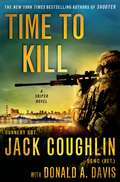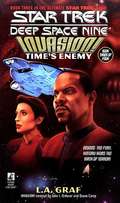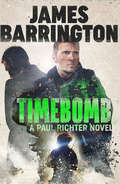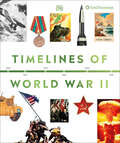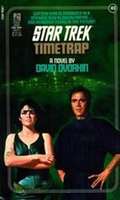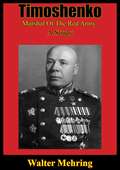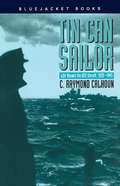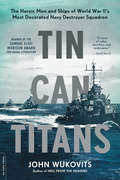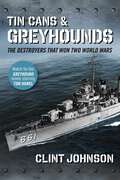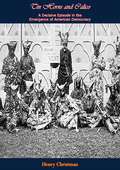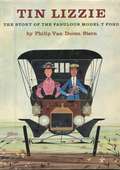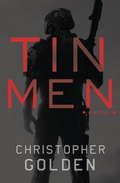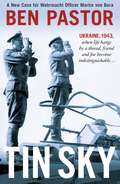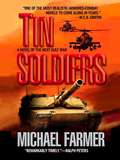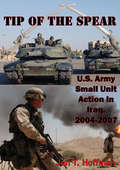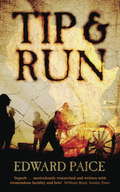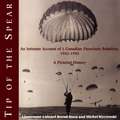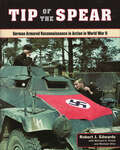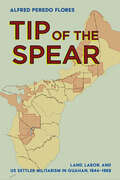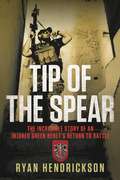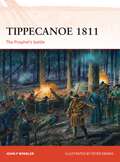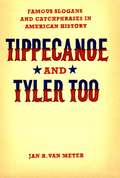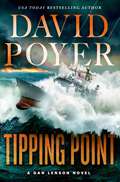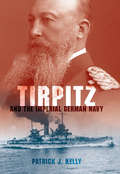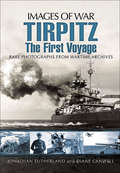- Table View
- List View
Time to Kill (Sniper Series #6)
by Jack Coughlin Donald A. DavisFrom the bestselling authors of Shooter and Running the Maze comes a chillingly realistic thriller about Islamic terrorists bent on delivering Egypt into the hands of America's archenemy--Iran. In the newest page-turner in the New York Times bestselling series featuring American sniper Kyle Swanson, an American accountant is murdered in his Maryland home by Iranian assassins. A goodwill visit to Cairo by Iran's national soccer team ends in a bloodbath. Egyptian missiles rain down on an Iranian Navy ship in the Red Sea, and Iran retaliates by landing elite troops at a popular Egyptian resort and attacking tourist hotels. The Muslim Brotherhood is on the march to bring Egypt under the political control of powerful Iran. Running the coup is a ruthless double agent called the Pharaoh, who will stop at nothing to establish an obedient puppet regime on Israel's border, and take complete control of the Suez Canal, the choke point for the world's oil flow. The United States will never allow that to happen, but options are limited and things are moving fast. Washington turns to Marine master sniper Kyle Swanson and the beautiful Egyptologist Tianha Bialy, a British Secret Service agent, who have been trapped behind the lines. Given free rein to attack the Iranian invaders, Swanson goes on a dangerous mission to prevent a total war in the Middle East, no matter what the cost.
Time's Enemy: Invasion! #3 (Star Trek: Deep Space Nine #16)
by L.A. GrafMillenia ago, an apocalyptic battle was fought in the Alpha Quadrant. The losers were banished, but what became of the victors? The Federation is threatened by this ancient mystery when a battered and broken version of the Defiant is found, frozen for five thousand years, in an icy cloud of cometary debris. Captain Sisko and the crew of Deep Space NineTM are summoned to answer the most baffling question of their lives: how and when will their ship be catapulted back through time to its destruction? And does its ancient death mean that one of the combatants in a primordial battle is poised now to storm the Alpha Quadrant? Only the wormhole holds the answer -- and the future of the Federation itself may depend on the secrets it conceals.
Timebomb (An Agent Paul Richter Thriller)
by James BarringtonA long-forgotten threat becomes a deadly new danger.What should have been a routine arrest near Geneva turns into a bloody shoot-out. Four terrorists and four policeman are left dead, with Paul Richter on the run from a murder charge.Back in the UK, a tramp is viciously murdered on the Isle of Sheppey. Then a surveillance operation in Stuttgart goes badly wrong when a mole tips off the terrorists.As Richter hunts for the connection between these widely separated events, he discovers a chilling plot: to use the world’s largest ever non-nuclear explosion to devastate the City of London, and leave thousands dead.The fifth Paul Richter novel showcases James Barrington as an elite thriller writer at the very height of his powers. With twists and turns aplenty, Timebomb is perfect for fans of Robert Ludlum, Frederick Forsyth and Brad Thor.
Timelines of World War II (DK Timelines)
by DKDiscover the stories behind the conflict that shaped the modern world in this richly illustrated guide to the Second World War.From the rise of fascism in Italy and Germany in the 1920s to the attack on Pearl Harbor, and the Battle of Stalingrad to the bombing of Hiroshima, through to the founding of the State of Israel in 1948, Timelines of World War II brings the key milestones of the conflict to life, explaining each of them through contemporary photos, documents, maps, and artifacts.This accessible and wide-ranging overview of WWII explores the key events and turning points of the conflict from around the world, from the Normandy Beaches to the jungles of Burma, and offers insights into the experiences of leaders, soldiers, and civilians involved.Stunning feature spreads showcase artworks, photographs, and other artifacts, while profile boxes bring to life the people, new technology, and milestone events that altered the course of the war.Offering a uniquely compelling, accessible, and immediate history of the war, Timelines of World War II will enthrall you with its compelling insight into the conflict and the important part it has played in modern history, whether you're a history student or a casual reader.
Timetrap (Star Trek: Vanguard #40)
by David DvorkinIn a remote area of Federation space, the Enerprise picks up an urgent distress signal -- from a Klingon vessel! Tracing the S.O.S., the crew finds the Klingon cruiser Mauler, trapped in a dimensional storm of unprecedented power. Yet paradoxically, the ship refuses both the Enterprise's call and the offers of help. Determined to discover what the Klingons are doing in Federation space, Kirk beams aboard their ship with a security team, just as the storm flares to its highest intensity. As the bridge crew watches in horror, Mauler vanishes from the Enterprise's viewscreen... And James T. Kirk awakens...one hundred years in the future.
Timoshenko, Marshal Of The Red Army: A Study
by Walter MehringAn interesting sketch of Marshal Timoshenko by a famous German dissident who fled to Russia when the Nazis came to power in his homeland."This book is not a biography.A final judgment cannot be reached about Timoshenko because, unlike the work of an artist or scientist who can be judged by a single accomplishment, the work of a general depends on the final result.This book is an attempt to study the Russian soldier from a socio-psychological viewpoint.It is not so much the history of an individual as of a type. Timoshenko is for us a characteristic product of Bolshevik militarism, a man who has lived through the entire development of the Soviet regime, from the initial overthrow of Tsarism to the present life and death struggle against the German invader."--From the Author's Foreword, 1942
Tin Can Sailor
by Charles R. CalhounMore than eight hundred sailors served aboard the Sterett during her hazardous and demanding duties in World War II. This is the story of those men and their beloved ship, recorded by a junior officer who served on the famous destroyer from her commissioning in 1939 to April 1943, when he was wounded at the Battle of Tulagi. Peppered with the kind of vivid, authentic details that could only be provided by a participant, the book is the saga of a gallant fighting ship that earned a Presidential Unit Citation for her part in the Third Battle of Savo Island, where she took on a battleship, cruiser, and destroyer and was the last to leave the fray. Calhoun's gripping and colorful account tells what it was like to be there during those furiously fought, close-range engagements. When published in hardcover in 1993, the book was widely praised as a good read loaded with rich and interesting details.
Tin Can Titans: The Heroic Men and Ships of World War II's Most Decorated Navy Destroyer Squadron
by John WukovitsAn epic narrative of World War II naval action that brings to life the sailors and exploits of the war's most decorated destroyer squadronWhen Admiral William Halsey selected Destroyer Squadron 21 (Desron 21) to lead his victorious ships into Tokyo Bay to accept the Japanese surrender, it was the most battle-hardened US naval squadron of the war.But it was not the squadron of ships that had accumulated such an inspiring resume; it was the people serving aboard them. Sailors, not metallic superstructures and hulls, had won the battles and become the stuff of legend. Men like Commander Donald MacDonald, skipper of the USS O'Bannon, who became the most decorated naval officer of the Pacific war; Lieutenant Hugh Barr Miller, who survived his ship's sinking and waged a one-man battle against the enemy while stranded on a Japanese-occupied island; and Doctor Dow "Doc" Ransom, the beloved physician of the USS La Vallette, who combined a mixture of humor and medical expertise to treat his patients at sea, epitomize the sacrifices made by all the men and women of World War II.Through diaries, personal interviews with survivors, and letters written to and by the crews during the war, preeminent historian of the Pacific theater John Wukovits brings to life the human story of the squadron and its men who bested the Japanese in the Pacific and helped take the war to Tokyo.
Tin Cans and Greyhounds: The Destroyers that Won Two World Wars
by Clint JohnsonFor men on destroyer-class warships during World War I and World War II, battles were waged “against overwhelming odds from which survival could not be expected.” Those were the words Lieutenant Commander Robert Copeland calmly told his crew as their tiny, unarmored destroyer escort rushed toward giant, armored Japanese battleships at the Battle off Samar on October 25, 1944. This action-packed narrative history of destroyer-class ships brings readers inside the half-inch-thick hulls to meet the men who fired the ships' guns, torpedoes, hedgehogs, and depth charges. Nicknamed "tin cans" or "greyhounds," destroyers were fast escort and attack ships that proved indispensable to America's military victories. Beginning with destroyers' first incarnation as torpedo boats in 1874 and ending with World War II, author Clint Johnson shares the riveting stories of the Destroyer Men who fought from inside a "tin can"—risking death by cannons, bombs, torpedoes, fire, and drowning. The British invented destroyers, the Japanese improved them, and the Germans failed miserably with them. It was the Americans who perfected destroyers as the best fighting ship in two world wars. Tin Cans & Greyhounds compares the designs of these countries with focus on the old, modified World War I destroyers, and the new and numerous World War II destroyers of the United States. Tin Cans & Greyhounds details how destroyers fought submarines, escorted convoys, rescued sailors and airmen, downed aircraft, shelled beaches, and attacked armored battleships and cruisers with nothing more than a half-inch of steel separating their crews from the dark waves.
Tin Horns and Calico: A Decisive Episode in the Emergence of American Democracy
by Carl Carmer Henry ChristmanA stirring tale of the antirent agitation in the Catskills, Hudson Valley and up-state New York in the 1840’s.“As the somewhat cryptic title suggests, this book is concerned primarily with one aspect of a many-sided theme in the economic and social history of New York state, and it deals with that topic in its final stage of popular protest and legal liquidation. During the first two centuries of New York's history the dominant form of landholding in the Hudson Valley was the large estate occupied by tenants on the quasi-feudal terms of annual rentals in kind or equivalent cash and the reservation of rights to share in land sales. Inaugurated by the Dutch and continued under English rule, this system of landholding was extended and reinvigorated after the Revolution in the guise of a permanent leasehold, mainly devised by Alexander Hamilton, the brother-in-law of Stephen Van Rensselaer, the last of the patroons and the principal landlord in the state.The rising tide of political democracy, coupled with economic distress and the accumulation of arrears, produced an inevitable popular reaction against the burdens of tenancy. The spark of revolt was struck in 1839, on the death of Stephen Van Rensselaer, when his heirs attempted to collect arrears by legal process. The result was an antirent agitation between 1839 and 1845, which flared up into sporadic violence and resistance to the sheriffs of several upstate counties by bands of farmers, summoned to the call of tin horns and disguised in calico robes and Indian masks. This in turn provoked collision with the state authorities upholding law and order.”-Journal of Economic History
Tin Lizzie: The Story of Fabulous Model T Ford
by Philip Van Doren Stern“In the 1920’s millions of Model T’s were on the road. More than 15,000,000 were made.”The fantastic story of the trendsetting Ford Model T is described in this book with numerous illustrations throughout. Exceptionally detailed and well researched this book is a must for any car or automobile enthusiast.
Tin Men
by Christopher GoldenBrad Thor meets Avatar in this timely thriller for the drone age as award-winning author Christopher Golden spins the troubles of today into the apocalypse of tomorrow. After political upheaval, economic collapse, and environmental disaster, the world has become a hotspot, boiling over into chaos of near apocalyptic proportions. In this perpetual state of emergency, all that separates order from anarchy is the military might of a United States determined to keep peace among nations waging a free-for-all battle for survival and supremacy. But a conflict unlike any before demands an equally unprecedented fighting force on its front lines. Enter the Remote Infantry Corps: robot soldiers deployed in war zones around the world, controlled by human operators thousands of miles from the action. PFC Danny Kelso is one of these "Tin Men," stationed with his fellow platoon members at a subterranean base in Germany, steering their cybernetic avatars through combat in the civil-war-ravaged streets of Syria. Immune to injury and death, this brave new breed of American warrior has a battlefield edge that's all but unstoppable--until a flesh-and-blood enemy targets the Tin Men's high-tech advantage in a dangerously game-changing counter strike. When anarchists unleash a massive electromagnetic pulse, short-circuiting the world's technology, Kelso and his comrades-in-arms find themselves trapped--their minds tethered within their robot bodies and, for the first time, their lives at risk. Now, with rocket-wielding "Bot Killers" gunning for them, and desperate members of the unit threatening to go rogue, it's the worst possible time for the Tin Men to face their most crucial mission. But an economic summit is under terrorist attack, the U.S. president is running for his life, and the men and women of the 1st Remote Infantry Division must take the fight to the next level--if they want to be the last combatants standing, not the first of their kind to fall forever. Advance praise for Tin Men "Tin Men is the literary equivalent of a muscle car: stylish and fast-paced, with a hopped-up engine of a plot. Christopher Golden starts things off at tire-burning speed and never lets up. It's a great ride--definitely as much fun as we can ever hope to have while the world falls to ruin around us."--Scott Smith, author of A Simple Plan and The Ruins "A chilling tale of a world that could be, Tin Men is a vicious beast--Starship Troopers meets Generation Kill--that left my nerves fried and my brain craving another fix."--Pierce Brown, author of Golden Son "When the human soul thrums inside machines of war, the ultimate weapon is born. Golden crafts a unique combination of Terminator and Saving Private Ryan."--Scott Sigler, author of Alive "As military robots proliferate, we have all wondered whether the wealthy will use them to dominate those with fewer resources. Fascinating and thrilling, Tin Men imagines a future in which the playing field is suddenly and violently leveled. When the stakes are life or death, will the soldiers behind the robots still have what it takes to survive?"--Daniel H. Wilson, author of Robopocalypse "This evocative tale of the possible and the probable takes a wild walk on the perilous side. Along the way, we get a top-of-the-line lesson in what may actually be in store for us one day. You're going to love this thrilling, taut drama."--Steve Berry, author of The Lincoln MythFrom the Hardcover edition.
Tin Sky
by Ben PastorFOURTH IN THE MARTIN BORA SERIES.SPELLBINDING MULTI-LAYERED CRIME NOVEL SET IN UKRAINE AS THE GERMANS REGROUP AFTER THE DISASTER OF STALINGRAD.FOR FANS OF PHILLIP KERR (BERNIE GUNTHER SERIES), ALAN FURST (SPIES OF THE BALKANS).THE HERO, MAJOR MARTIN BORA, IS AN ARISTOCRATIC GERMAN OFFICER OF THE ILK OF CLAUS VON STAUFFENBERG, TORN BETWEEN HIS DUTY AS AN OFFICER AND HIS INTEGRITY AS A HUMAN BEING.Ukraine, 1943. Having barely escaped the inferno of Stalingrad, Major Martin Bora is serving on the Russian front as a German counterintelligence officer. Weariness, disillusionment, and battle fatigue are a soldier's daily fare, yet Bora seems to be one of the few whose sanity is not marred by the horrors of war.As the Wehrmacht prepare for the Kursk counter-offensive, a Russian general defects aboard a T-34, the most advanced tank of the war. Soon he and another general, this one previously captured, are found dead in their cells. Everything appears to exclude the likelihood of foul play, but Bora begins an investigation, in a stubborn attempt to solve a mystery that will come much too close to home.
Tin Soldiers
by Michael FarmerAn alliance with Iran reinvigorates the Iraqi military. To prevent a total conquest of the region, a U.S. Army Heavy Brigade must stand against Iraq's greater numbers and updated technology-while the locals are bent on grinding the small American force into the ancient desert sand.
Tip Of The Spear: U.S. Army Small Unit Action In Iraq, 2004-2007 [Illustrated Edition]
by Jon T. HoffmanRichly illustrated with 12 maps and 46 photos.The lightning campaign that toppled the Saddam Hussein regime in Iraq in the spring of 2003 seemed to herald the arrival of a new way of war, as Germany's blitzkrieg had done at the beginning of World War II. But the initial victory soon devolved into a persistent counterinsurgency conflict reminiscent of the long U.S. effort to pacify the Philippines after the rapid defeat of Spain in 1898. In Iraq, American soldiers and their Coalition partners had merely traded one fairly weak and generally conventional opponent for a more deadly, diverse, and determined foe relying on the tactics of the guerrilla and the terrorist.This volume focuses on that second and longer campaign. But rather than a narrative of the overall course of the conflict, it provides a soldier's-eye view of the war by focusing on detailed accounts of selected engagements. Each illustrates the everyday challenges that America's soldiers faced in a difficult struggle against an inventive and often elusive enemy. Weapons, doctrine, and procedures developed to fight a conventional campaign against a similar opposing force had to be adapted to fit a different type of conflict. The U.S. Army's combat and support forces brought both resourcefulness and resilience to this task while continuing to demonstrate the same courage shown by previous generations fighting the nation's battles.These stories not only symbolize the tip of the spear formed by units in contact, but they also represent the contributions of all American men and women who have served their country in Operation Iraqi Freedom. Taken together, these accounts will provide our deploying leaders and soldiers a better understanding of the environment that they will encounter and prepare them for the work that must be done.
Tip and Run: The Untold Tragedy of the Great War in Africa
by Edward PaiceControversial and groundbreaking account of the infamous East African campaign during First World WarIn the aftermath of the Great War the East Africa campaign was destined to be dismissed by many in Britain as a remote 'sideshow' in which only a handful of names and episodes - the Königsberg, von Lettow-Vorbeck, the 'Naval Expedition to Lake Tanganyika' - achieved any lasting notoriety. But to the other combatant powers - Germany, South Africa, India, Belgium and Portugal - it was, and would remain, a campaign of huge importance. A 'small war', consisting of a few 'local affairs', was all that was expected in August 1914 as Britain moved to eliminate the threat to the high seas of German naval bases in Africa. But two weeks after the Armistice was signed in Europe British and German troops were still fighting in Africa after four years of what one campaign historian described as 'a war of extermination and attrition without parallel in modern times'.The expense of the campaign to the British Empire was immense, the Allied and German 'butchers bills' even greater. But the most tragic consequence of the two sides' deadly game of 'tip and run' was the devastation of an area five times the size of Germany, and civilian suffering on a scale unimaginable in Europe. Such was the cost of 'The White Man's Palaver', the final phase of the European conquest of Africa.
Tip of the Spear: An Intimate Account of 1 Canadian Parachute Battalion, 1942-1945
by Colonel Bernd Horn Michel WyczynskiIn the midst of the Second World War, the Germans introduced a new kind of warfare that had never been seen before, featuring a new kind of soldier: the paratrooper. The public and military alike were astonished by the feats of daring and martial prowess displayed by the intrepid troops, who soon became the epitome of the modern combat soldier. The Allies countered by setting up their own airborne forces. In Canada, 1 Canadian Parachute Battalion was established to serve as the "tip of the spear" of Allied attacks. In fact, it was this battalion that was first into Normandy for the D-Day invasion. Tip of the Spear tells in stunning black-and-white pictures the story of the Battalion from its inception in 1942 to its disbandment in 1945. Without question, the Battalion - or more accurately, its members - laid the foundation and established the airborne legacy that other Canadian airborne establishments could proudly follow and build on.
Tip of the Spear: German Armored Reconnaissance in Action in World War II
by Robert J Edwards Michael H Pruett Michael OliveA comprehensive pictorial study of Germany&’s armored reconnaissance operations across all WWII combat zones. From the invasions of Poland and France to the advances on the Eastern Front and in North Africa, German tank and infantry units unleashed brutal displays of power. But it was the German armored reconnaissance that laid the groundwork for these stunning victories. In Tip of the Spear, delves into German reconnaissance operations through firsthand accounts, after-action reports, and an extensive collection of wartime photographs. The author of Scouts Out, the first extensive treatment of the subject in English, Edwards delves deeper into the subject of German reconnaissance with extensive analysis of everything from tactics and doctrine to vehicles and commanders.
Tip of the Spear: Land, Labor, and US Settler Militarism in Guåhan, 1944–1962 (The United States in the World)
by Alfred Peredo FloresIn Tip of the Spear, Alfred Peredo Flores argues that the US occupation of the island of Guåhan (Guam), one of the most heavily militarized islands in the western Pacific Ocean, was enabled by a process of settler militarism. During World War II and the Cold War, Guåhan was a launching site for both covert and open US military operations in the region, a strategically significant role that turned Guåhan into a crucible of US overseas empire. In 1962, the US Navy lost the authority to regulate all travel to and from the island, and a tourist economy eventually emerged that changed the relationship between the Indigenous CHamoru population and the US military, further complicating the process of settler colonialism on the island.The US military occupation of Guåhan was based on a co-constitutive process that included CHamoru land dispossession, discursive justifications for the remaking of the island, the racialization of civilian military labor, and the military's policing of interracial intimacies. Within a narrative that emphasizes CHamoru resilience, resistance, and survival, Flores uses a working class labor analysis to examine how the militarization of Guåhan was enacted by a minority settler population to contribute to the US government's hegemonic presence in Oceania.
Tip of the Spear: The Incredible Story of an Injured Green Beret's Return to Battle
by Ryan HendricksonThe inspiring true story of a US Special Forces soldier who was medically retired after stepping on an IED, and his incredible return to active duty.Sergeant First Class (SFC) Ryan Hendrickson is a brave, determined, and courageous soldier -- a Green Beret clearing the way for his twelve-man team while conducting combat operations against the Taliban. As the "tip of the spear," his role is to ensure the route taken by U.S. and Afghan troops are free of IEDs -- improvised explosive devices. Many soldiers do not survive their last step; those who do often lose at least one limb.While rescuing an Afghan soldier outside a mud-hut compound in 2010 -- knowing that he was in "uncleared" territory -- Ryan stepped on an IED with his right foot. The device exploded, leaving his foot dangling at the end of his leg.American soldiers losing a limb is an all-too-common occurrence. But what makes Ryan's story different is that after undergoing two dozen surgeries and a tortuous rehabilitation, he was medically retired but fought to return to active duty. Multiple skin grafts to his leg and right foot successfully reattached his lower leg, and he was aided in his recovery by wearing a new prosthetic device known as an IDEO (Intrepid Dynamic Exoskeletal Orthosis). Once he passed a series of crucial physical tests, Ryan was able to rejoin the Green Berets within a year and physically perform his duties, redeploying to Afghanistan in March 2012.In 2016, he volunteered to return to Afghanistan with Bravo Company, 2nd Battalion, 7th Special Forces Group. During a firefight with the Taliban, he risked his life under heavy enemy fire to rescue three Afghan soldiers cut off from friendly forces and return the bodies of two dead Afghan soldiers under the ethos that "no one gets left behind." For his heroic efforts on the battlefield, SFC Ryan Hendrickson was awarded a Silver Star, the nation's third-highest award for valor.An engaging and harrowing account, Tip of the Spear tells the amazing story of one Green Beret's indomitable spirit.
Tippecanoe 1811
by Peter Dennis John F. WinklerThis is the gripping story of the Tippecanoe campaign of 1811: "The prophet's battle". It was a conflict born out of festering tensions inscribed by the 1795 Treaty of Greeneville, which had concluded the Northwestern Indian War and attempted to prevent white settlers' encroachment onto newly-defined Indian territories. For 16 years there had been peace, but in 1811 the number of settlers in the Ohio territory had swollen from 3,000 to 250,000. War was again coming to the North West. Within these pages John F. Winkler explores the dramatic buildup to the war and provides a clear view of the intense fighting with the aid of superb illustrations and maps. He explores the mystical figure of Tenskatawa, who came to be known as "The prophet" and who tried to unite the tribes of the Northwest to drive the American settlers back once and for all - promising a great success that he had seen in a vision. However it was his brother, the charismatic war leader Tecumseh who would organize the tribes militarily, and the Battle of Tippecanoe would be joined as a stealthy assassination attempt by 100 hand-picked warriors trying to kill William Henry Harrison. Kill Harrison, The Prophet asserted, and the rest would fold. Uncover the truth about the brutal combat that followed, and the impact of the battle on the War of 1812.
Tippecanoe and Tyler Too: Famous Slogans and Catchphrases in American History
by Jan R. Van MeterIn individual entries on slogans and catchphrases from the early seventeenth to the late twentieth century, Jan Van Meter reveals that each one is a living, malleable entity that has profoundly shaped and continues to influence our public culture. From John Winthrop's "We shall be as a city upon a hill" to Martin Luther King Jr.'s "I have a dream" and Ronald Reagan's "Mr. Gorbachev, tear down this wall", each of Van Meter's selections emerges as a memory device for a larger political or cultural story. Taken together in Van Meter's able hands, these famous slogans and catchphrases give voice to our common history even as we argue about where it should lead us.
Tipping Point (A Dan Lenson Novel #15)
by David PoyerCaptain Dan Lenson is under fire both at sea, and in Washington. His command of the first antiballistic-missile-capable cruiser in the Fleet, USS Savo Island, is threatened when he's called home to testify before Congress. There, he must defend his controversial decision to prevent a massive retaliatory missile attack by Israel against civilian targets in the Mideast. Shaken by the near-end of his career, Lenson returns to command uncertain of his own future, but determined to do his best by a damaged ship and an increasingly divided crew. Ordered to the Indian Ocean, Savo cruises off East Africa, protecting shipping lanes from pirates. But this seemingly-routine patrol turns ominous when an unknown assailant begins assaulting female crew members. But then, an explosive showdown begins between India and Pakistan. . . with Savo Island, and her unique but not yet fully battle-ready ability to intercept ballistic missiles, standing alone between two nations on the brink of the first theater nuclear war. Dan will have to battle tsunami-driven seas, incoming weapons, and a quickly tilting balance of power, as China moves inexorably in her bid to displace America in the far Pacific. The fifteenth novel in David Poyer's acclaimed series of naval adventures featuring Dan Lenson,Tipping Point is an action-packed, utterly authentic story of duty, war, and the stress of command, by the most popular living author of American sea fiction.
Tirpitz: And the Imperial German Navy
by Patrick J. Kelly&“A first-rate biography of this grand admiral who is better known for his political skills than his naval ones.&” —US Naval Insitute Proceedings Grand Admiral Alfred von Tirpitz (1849–1930) was the principal force behind the rise of the German Imperial Navy prior to World War I, challenging Great Britain&’s command of the seas. As State Secretary of the Imperial Naval Office from 1897 to 1916, Tirpitz wielded great power and influence over the national agenda during that crucial period. By the time he had risen to high office, Tirpitz was well equipped to use his position as a platform from which to dominate German defense policy. Though he was cool to the potential of the U-boat, he enthusiastically supported a torpedo boat branch of the navy and began an ambitious building program for battleships and battle cruisers. Based on exhaustive archival research, including new material from family papers, Tirpitz and the Imperial German Navy is the first extended study in English of this germinal figure in the growth of the modern navy. &“Well written and based on new sources . . . allows the reader deep insights into the life of a man who played a very important role at the turn of the last century and who, like almost nobody else, shaped German policy.&” —International Journal of Maritime History &“An invaluable reference work on Tirpitz, the Imperial German Navy, and on politics in Wilhelmine Germany.&” —The Northern Mariner
Tirpitz: The First Voyage (Images Of War Ser.)
by Diane Canwell Jonathan SutherlandThe photos in this book are taken from an unpublished album belonged to a member of the crew of famous German Battleship Tirpitz. It is a little known fact that before the start of World War Two the ship went on a shakedown voyage into the Atlantic, traveling north into Arctic waters and south into the more tropical climbs of the Caribbean. There are superb photos of the officers and crew both above and below decks, including some unique shots of the crew during their stint on a magnificent sail training vessel. Other stunning shots show the vessels mighty weapons during gunnery practice during her sea trials. This unique collection gives a close up view of one of the most powerful ships of World War Two, a ship that proved to be a persistent thorn in the side of the Royal Navy until sunk in Norway towards the end of the war.\
